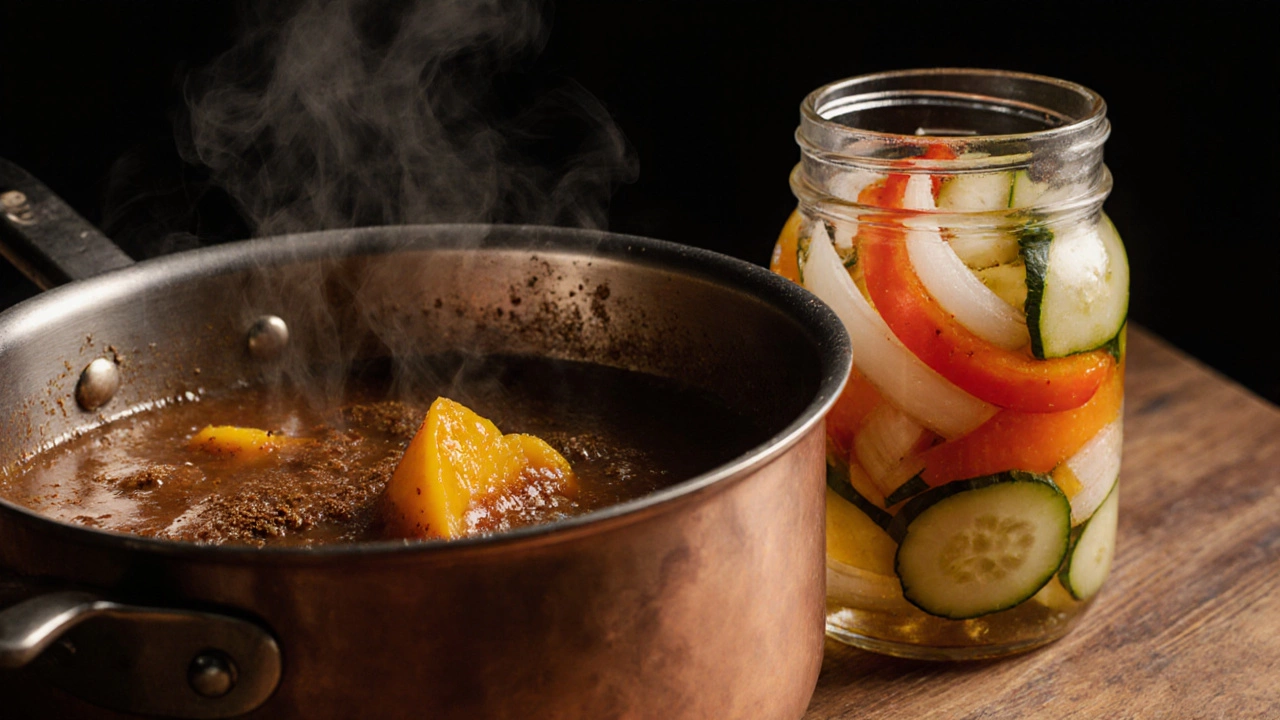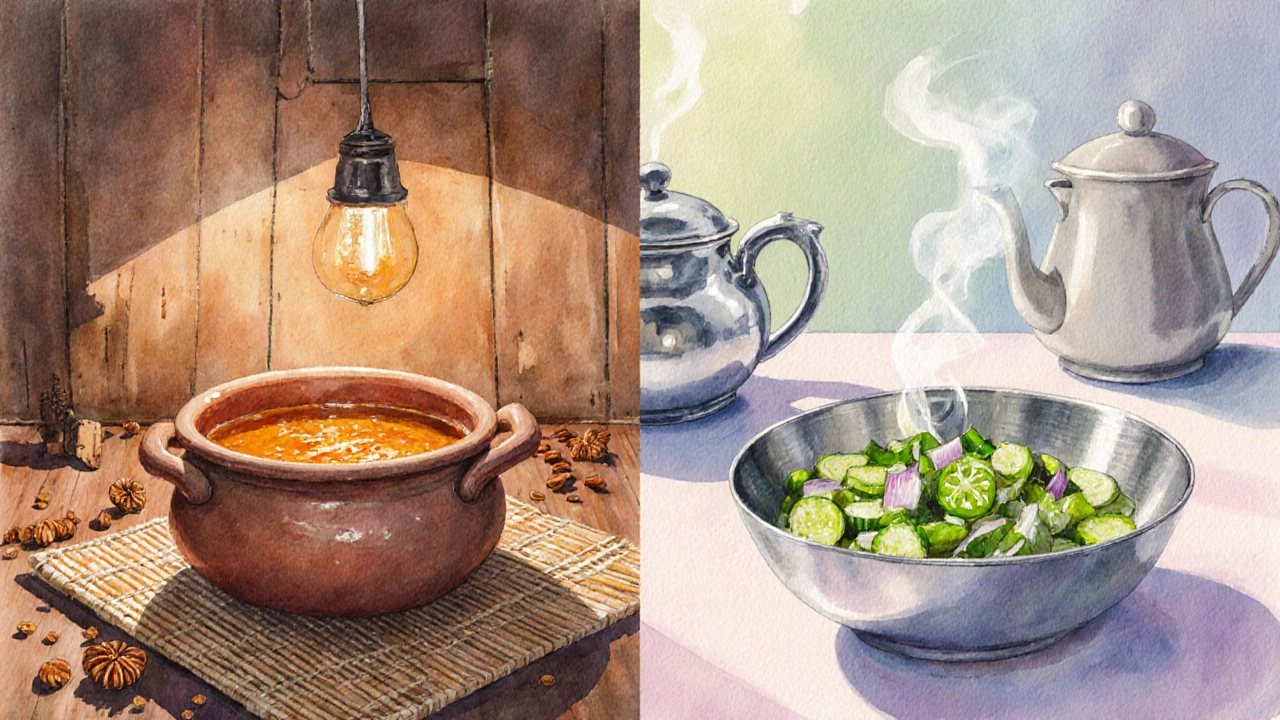Chutney vs Relish Decision Guide
Recommended Condiment
Ever wondered why recipes sometimes call for chutney while others say relish? They might look similar-a mix of fruit, veg, and spice-but they serve different roles in the kitchen. This guide breaks down the distinction so you can pick the right one every time.
When you hear chutney is a cooked condiment originating from Indian cuisine, typically made by simmering fruit or vegetables with sugar, vinegar, and a blend of spices until it reaches a jam‑like consistency, think of a sweet‑tangy spread that can be smooth or chunky. By contrast, relish is a coarser, often uncooked or lightly pickled mixture of chopped vegetables or fruits, seasoned with vinegar, sugar, and spices, common in British and American kitchens sits somewhere between a fresh salsa and a pickle.
Where they started
The word “chutney” comes from the Hindi‘chatni’, meaning “to lick”. It traveled with British colonials in the 18thcentury and quickly became a pantry staple in Indian cuisine the diverse culinary traditions of the Indian subcontinent. British cooks, facing a shortage of fresh herbs during the rainy months, adapted the idea into a sweeter, more shelf‑stable form, giving rise to the modern chutney many of us buy in jars.
Meanwhile, British cuisine the traditional cooking of the United Kingdom cultivated its own version of a tangy side dish called “relish”. Early recipes appeared in 19th‑century cookbooks, often featuring pickled onions, cucumbers, or cabbage. Over time, relish evolved into the bright, sweet‑sour accompaniment you find on hot dogs and cheese boards today.
Core ingredients and flavor profile
Both condiments rely on three pillars: fruit or veg, an acid (usually vinegar), and a sweetener. The balance, however, shifts.
- Mango is the star of many Indian chutneys fruit‑based variations that can be hot, sweet, or a mix of both. The fruit is cooked down, often with brown sugar, creating a deep, caramelised flavor.
- Vinegar the acidic component that preserves and brightens both chutney and relish plays a bigger role in relish, where the vinegar ratio can be as high as 30% of the mix, giving it a sharp bite.
- Spice blends differ: Indian chutneys lean on spice ground or whole aromatics such as cumin, mustard seeds, and garam masala, while British relishes stick to milder agents like mustard powder, celery seed, and a dash of pepper.
The result? Chutney leans sweet‑tart with warm, aromatic heat; relish leans bright‑tart, often with a sharper, cleaner acidity.
Texture matters
Chutney can range from a silky jam‑like spread to a chunky salsa, but it’s usually cooked long enough that the pieces break down and the mixture thickens. Relish, on the other hand, is deliberately left with distinct pieces - think diced peppers, corn kernels, or cucumber slices - giving it a crunch that survives a quick spoonful onto a burger.
How you use them
Because of its richer, sweeter profile, chutney pairs well with grilled meats, roasted vegetables, and hearty legumes. A dollop on a plate of butter chicken or a swirl into a bean curry can elevate the dish without overpowering it.
Relish shines as a topping for sandwiches, hot dogs, cheese boards, and even as a glaze for pork ribs. Its crisp bite cuts through rich fats and adds a pop of colour.

Storage and shelf life
Both are preserved, but the cooking process in chutney gives it a longer unopened shelf life - often 12‑18months in a sealed jar. Once opened, keep it refrigerated and use within 2‑3weeks. Relish, being less cooked, usually lasts 6‑12months unopened and about a month after opening, provided it stays chilled.
Quick decision guide
- If you need a sweet, aromatic spread for Indian‑style dishes → reach for chutney.
- If you want a bright, crunchy bite for burgers or cheese plates → go with relish.
- Consider the base fruit/veg: mango, tamarind, or pineapple signal chutney; cucumber, onion, or bell pepper signal relish.
- Check the ingredient list for cooking time - simmered = chutney; quick‑pickled = relish.
Side‑by‑side comparison
| Aspect | Chutney | Relish |
|---|---|---|
| Origin | Indian cuisine | British/American cuisine |
| Typical base | Mango, tamarind, coconut | Cucumber, onion, pepper |
| Cooking method | Simmered (often hours) | Quick pickled or raw |
| Texture | Jam‑like to chunky | Coarse, crunchy |
| Flavor focus | Sweet‑tart with warm spices | Bright‑tart with mild spices |
| Common uses | Curries, grilled meats, cheese boards | Hot dogs, sandwiches, roasted pork |
| Shelf life (unopened) | 12‑18months | 6‑12months |
Common pitfalls and pro tips
- Don’t over‑sweeten chutney if you plan to serve it with very spicy dishes - a 1:1 sugar to fruit ratio is usually safe.
- For relish, slice vegetables uniformly to ensure even pickling and a tidy look on the plate.
- Always sterilize jars before storing either condiment; it prevents off‑flavors and extends freshness.
- Experiment with hybrid versions - a semi‑cooked mango relish can bridge the two worlds for a unique dip.
Frequently Asked Questions
Can I substitute chutney for relish in a hot dog?
You can, but expect a sweeter, softer topping. If you like a hint of spice, choose a mango or tomato‑based chutney that isn’t too thick.
Is relish always made with vinegar?
Traditional British relish relies on vinegar for preservation and tang. Some modern American versions skip the vinegar in favor of lemon juice, but the acidic component is still essential.
How long can I keep homemade chutney in the fridge?
Stored in a clean, airtight jar, homemade chutney lasts about 2‑3weeks in the refrigerator. For longer storage, process it in a water‑bath canner and keep it in a cool, dark pantry.
What spices give chutney its signature heat?
Typical heat comes from green or black chilies, mustard seeds, and sometimes a pinch of cayenne. Adjust the amount to match your tolerance.
Can I make relish without cooking?
Yes. Quick‑pickled relishes are made by tossing chopped veg in a hot vinegar‑sugar‑spice mixture, then cooling. The heat from the liquid “cooks” the vegetables enough for safe storage.
